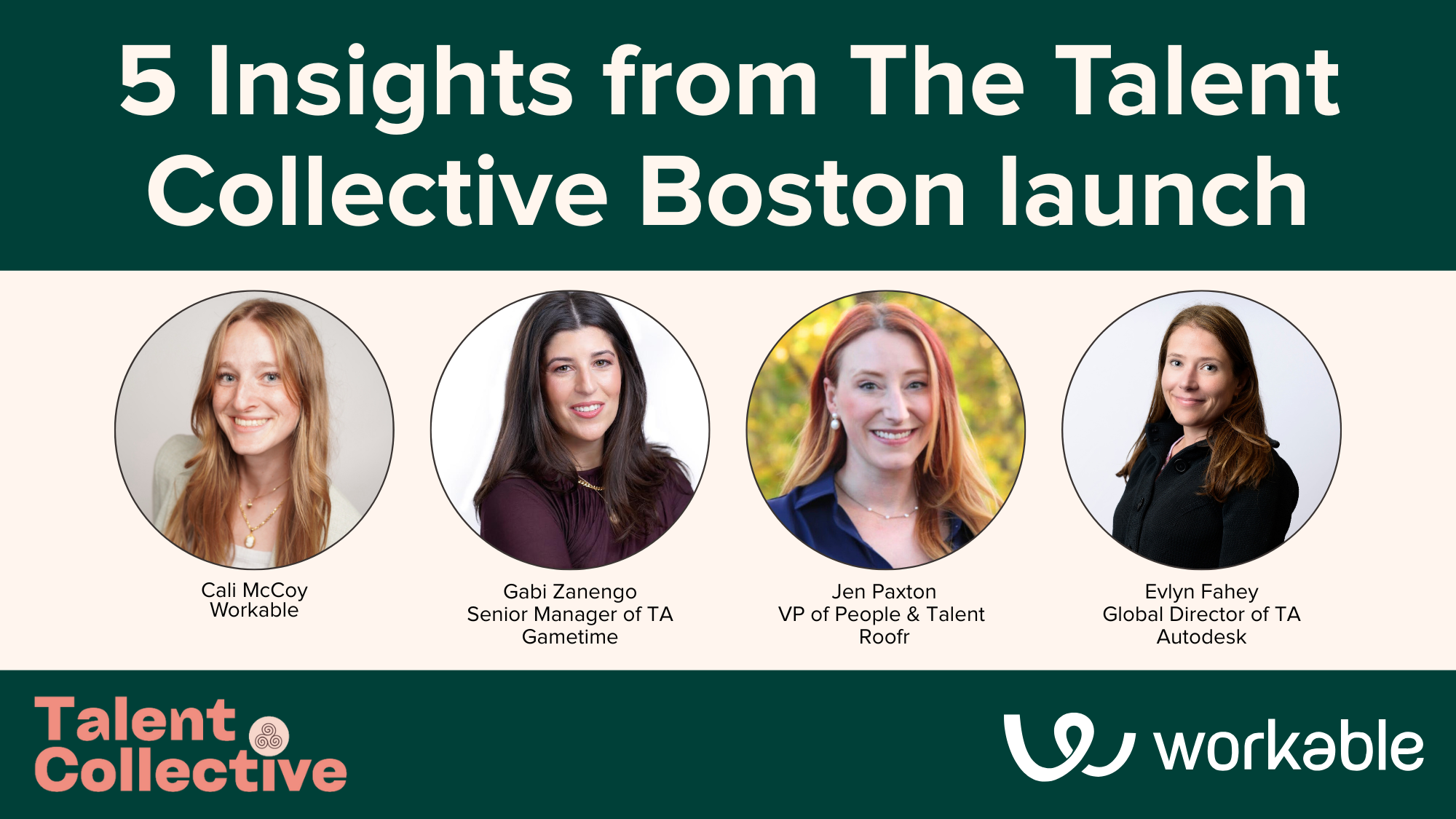5 candidate experience pitfalls in 2023 – and how to fix them
To attract great talent and retain employees, it's crucial to create an exceptional candidate experience. With a tight labor market, candidates expect clear communication, transparency on pay and benefits and a structured interview process. By avoiding common pitfalls and investing in your employer brand, you can improve your hiring process and build positive relationships with potential candidates.

This talent market is unlike any other that talent acquisition and PeopleOps leaders have seen. With companies announcing layoffs and others hiring like hotcakes, it’s a bit of a challenge for anyone to know which way is up.
But one trend that remains constant is that companies are putting a strong emphasis on how they will improve their hiring process and employee retention during this time. As companies navigate a surge of inflation, a tight labor market and a looming recession, they need to find new ways to balance efficiency and engagement when it comes to the candidate experience.
Candidates’ expectations of the interview process have changed dramatically and companies are struggling to keep up. Candidates want to understand the overall strategy companies will take to ensure an inclusive interview process.
They want to know what to expect from the process and when they will hear back (i.e. not be ghosted). During the interview process they are asking more questions about work-life balance to understand the inner workings of the organization, to ensure that they connect with the company’s culture and mission on a deeper level.
If companies can improve their candidate experience, this will not only elevate and streamline their hiring processes but should mitigate some of the risk of attrition due to a misalignment of values.
While having a ‘white glove’ candidate experience can seem like a daunting task, there are a few pitfalls that talent acquisition and PeopleOps leaders should avoid when thinking about their candidate experience:
Contents
1. Not setting clear communication around the interview process
A long drawn-out interview process can be detrimental to hiring. We’ve all seen the posts by candidates talking about how slow a company’s hiring process can be or a candidate can think that the process is over but then they find out that there are more rounds of interviews the company wants them to go through.
If candidates do not know what to expect as the next steps throughout the entire interview process or if they experience delays or deviations from the original plan, they can start to wonder if their time will be as undervalued working for your company as you are treating them in the interview process.
Just like in sales, time kills all deals, so a slow recruiting process diminishes offer acceptance rates.
What you can do:
Keep hiring managers accountable. Track their process, advocate that this be one of their OKRs.
Set a clear plan in the recruiting kickoff meeting of what the plan is going to be. Set SLAs with interviewers that they will get back to you with feedback within X days.
Before and after an interview, let the candidate know what to expect next and when they should hear back. If there are going to be delays, let them know sooner. Then, if you get back to them by the time you originally said you would, they could be pleasantly surprised.
2. Overselling and underdelivering of pay and benefits
A growing number of states have passed legislation that requires companies to post their salary ranges in their job descriptions, however some companies are finding workarounds.
They’re posting unrealistic ranges, being cagey around their work-from-home policies and not talking about the benefits that they offer employees until the offer stage.
What you can do:
Post a realistic salary range on your roles
Be realistic with your ranges. A good salary range would be $100,000-$130,000. A bad salary range would be $50,000-$500,000.
You may lose some candidates upfront who are looking for more money but it is better to know in the beginning what they need than to find out at the end after you have invested time and energy into interviewing them.
Also, candidates may surprise you. If they are interested in the role, they may reach out at the beginning to see if you have any flexibility in the range or inquire about other things in the comp package that might sway them to take less money.
Be upfront about the benefits that you offer
Benefits are big factors in a candidate’s decision making process when looking for a new role.
For example: you cover 100% healthcare, you have unlimited PTO with a three-week minimum, and you have a learning & development stipend. Put those details in the job description, talk about them in the screening process and, better yet, share a video that talks about them in the interview process or on your site.
Let candidates know where you stand on remote work
If you require people to be in the office X days a week, let them know before they hit apply. If you offer the flexibility to work in another state/country for three months, put that in your job description under benefits.
You want to give candidates as much data as you can about your company, including culture, benefits and processes, so they can make an informed decision.
Be a human, not a ghost
Ghosting is a big concern for candidates this year. Candidates can feel like they are submitting their resume into a black hole. Or, if candidates do get an interview, the recruiter may disappear after the screening stage with no signal as to their status.
There are many things recruiters are juggling right now, but something that should be foundational is replying to every candidate, even if it’s a short one. Often, a candidate is just thankful that they got the standard rejection email instead of being left in hiring limbo.
3. Not having a structured interview process
Many candidates talk about how much time they spend preparing for an interview, learning the ins and outs of the company and practicing their interview responses, only to be met with an interviewer who is not prepared and “half asses” the interview.
It’s not the best experience interviewing with a company where you have each interviewer ask you the same question. As far as gathering data on if the candidate is a good fit or not, it doesn’t do the company any favors either.
What you can do:
Train hiring team members on how to conduct a great interview. Teach them how to talk in a welcoming manner, ask appropriate questions and interact in a respectful way with all candidates.
Have a clear understanding of what skills/competencies you are looking for in the role. Meet with each interviewer to align on the role and calibrate what a “good” vs. “great” response might look like.
Focus each interview around two to four competencies based on the details of the role. When each interviewer understands the competencies they are going to focus on, they can start to craft specific questions they will ask during the interview process.
4. Not having clear expectations for the role
Job descriptions are the first thing a candidate looks at to determine if the role is going to be the right fit for them. They will use this as a guide throughout the entire interview process.
In some cases, there can be a huge disconnect between what is written in the job description and what is said during an interview process. This can leave the candidate feeling confused as to what the day-to-day would really be in the role.
In addition to lacking details on the day-to-day responsibilities, more and more candidates are asking what the growth path looks like for the role they are applying for. Candidates are looking for opportunities to acquire new skills, take on new challenges and broaden the scope of their responsibilities within a company.
However, many companies struggle to plan for how they will use their new employee’s talents past the role that they are hired for, and this can have a big impact on a company’s ability to innovate.
What you can do:
Ensure that what is said in the posting is reflected in the words being said in the interview process. You can do this in the kickoff meeting with all of the interviewers by going over the specifics of the role, what a typical day looks like and what some potential growth paths might look like moving forward.
Candidates are most likely juggling more than just your opportunity so you should send follow-ups or prep videos with information to candidates about the day to day of the role. You can share these with them throughout the interview process.
If internal mobility is something that your company can support, provide examples of how others at the company have made internal moves.
You should meet with the hiring manager to talk about the growth of their team. That way, everyone in the interview process can set realistic expectations and not sell the candidate on a dream that will never come true.
5. Not investing in the employer brand
Job seekers look at review sites, your careers page and any other materials you put on social media as signals for what they can expect in the interview process and to help them understand what it is like to work at your company.
In fact, according to Glassdoor, 69% of candidates are more likely to apply to a company if the employer brand is actively managed. Even then, companies still struggle to tell an authentic story about what makes their company unique before candidates apply and throughout the interview process.
What you can do:
Have a compelling careers page with real photos & videos of employees. Include a clear mission, vision, and value statements and information on the benefits that the company offers.
Leverage video content with employee testimonials on social media and share with candidates during touchpoints throughout the entire interview process.
Actively manage your reputation on sites like Glassdoor and Comparably by checking company’s reviews and responding to questions and complaints.
Improve your candidates’ experience
There are a ton of amazing candidates out there who will apply to your roles, some of which you will be able to hire today and others who you will want to build a positive relationship with so that they are more likely to apply when another role becomes available.
Avoiding these common pitfalls will help you to create a positive candidate experience and a company applicants will want to refer their friends to.
Frequently asked questions
- Why is it important to improve the candidate experience?
- Improving the candidate experience is important because it helps companies attract and retain top talent, reduce the risk of attrition due to a misalignment of values, and streamline their hiring processes. Candidates have high expectations of the interview process and want to understand a company's overall strategy to ensure an inclusive experience.
- How can companies communicate better with candidates during the interview process?
- Companies can communicate better with candidates during the interview process by setting clear communication plans, holding hiring managers accountable, setting SLAs with interviewers, letting candidates know what to expect before and after interviews, and notifying candidates of any delays or deviations from the original plan.
- How can companies avoid overselling and underdelivering of pay and benefits?
- Companies can avoid overselling and underdelivering of pay and benefits by posting realistic salary ranges, being upfront about benefits in the job description and screening process, and being clear about where they stand on remote work.
- How can companies have a structured interview process?
- Companies can have a structured interview process by training hiring team members on how to conduct a great interview, having a clear understanding of what skills/competencies they are looking for in the role, focusing each interview around two to four competencies, and meeting with each interviewer to align on the role and calibrate what a "good" vs. "great" response might look like.
- How can companies invest in their employer brand?
- Companies can invest in their employer brand by having a compelling careers page with real photos and videos of employees, including a clear mission, vision, and value statements, leveraging video content with employee testimonials on social media, and actively managing their reputation on sites like Glassdoor and Comparably by responding to questions and complaints.



